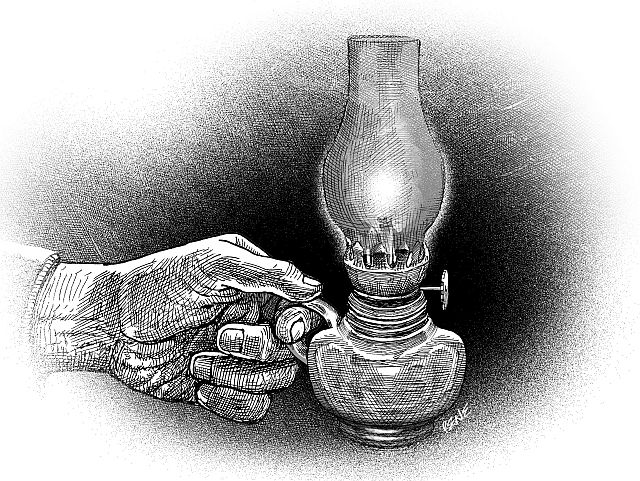
The kerosene lamp lit up the nights of my childhood. Electricity came to our town only years after I, then in my late teens, had left home. We had to make do with the Petromax, a brand name which became generic and was used for pressurized lamps of other brands, such as Coleman and Colemax.
The sunset would find me at home squatting on the floor, in front of the Petromax, pouring kerosene into its tank and with a match igniting the alcohol in a little boat inside to heat it, and pumping in air and turning a knob to fire up the gas mantle with an incandescent white light. Inside, this would be our main illumination for the night (outside, the moon).
To move about, we had other, smaller lamps, those with wicks. They were simple gadgets, fashioned out of empty tin cans. Still, because of their giveaway price, we chose to buy them at the public market instead of putting them together ourselves. The households near us, that did not have the convenience, relied on the tin can lamp in case any of their members felt the need to rush to the bushes, and those who saw a lamplight behind the weeds and wild sugarcane knew that someone had claimed an urgent, private space in the dark.
I remember the kerosene lamps with wicks and glass chimneys. Though not as luminous as the Petromax, the glass lamp, which we kept on a center table, had style and elegance. Everything about it was transparent, and I could see the coiled wick in the tank, stretching straight up, like a snake with a blazing head. The glass chimney looked like two transparent hands seamlessly clasped around the flame, and the mellow light cast around the room had the glow of prayer.
At times, I get the urge to scour the antique shops and start a collection of stately, old glass lamps. But then I would have to assign a night to light one of them, each having its turn, because an unlighted lamp is a lamp without a soul.
Indeed, the lighted lamp bespeaks watchfulness. In his Gospel, Luke writes of Jesus saying, “See that you have your belts done up and your lamps lit.
Be like people waiting for their master to return from the wedding feast, ready to open the door as soon as he comes and knocks.”
This is part of a discourse he gave to his disciples, in which Jesus likewise said, “’There is no need to be afraid, little flock, for it has pleased your Father to give you the kingdom. Sell your possessions and give to those in need. Get yourselves purses that do not wear out, treasure that will not fail you, in heaven where no thief can reach it and no moth destroy it. For wherever your treasure is, that is where your heart will be too.”
We ourselves are the lamp. In a poem, Emily Dickinson writes, “The Poets light but Lamps – / Themselves – go out – / The Wicks they stimulate / If vital Light / Inhere as do the Suns – / Each Age a Lens – / Disseminating their / Circumference –”
Dickinson compares writing a poem to lighting a lamp, after which the poet himself goes out and only the light remains, but only if it has vibrancy, life, like the sun. As to the poem’s value, time puts it under a lens to see how far it goes.
The lamp being me, I keep it lighted for the Lord, for his coming. It is my life, my treasure. As a sign of vigilance, I should spend the time tending to the flame.
I imagine myself coming home in the evening after a hard day, and being elated to step into a lamp’s soft glow in the living room. It would mean that the wife had expected my arrival and, knowing my desire for the right setting, filled the lamp with kerosene and trimmed and lighted its wick, adjusting the flame to a tender brightness. My heart aflutter, I would look around for her, knowing that she was near.